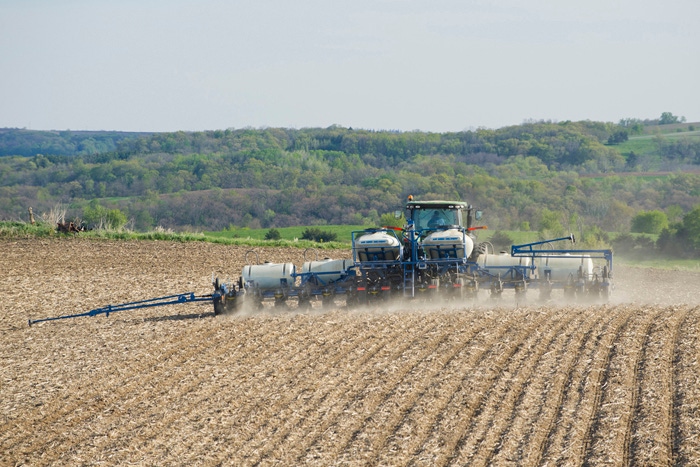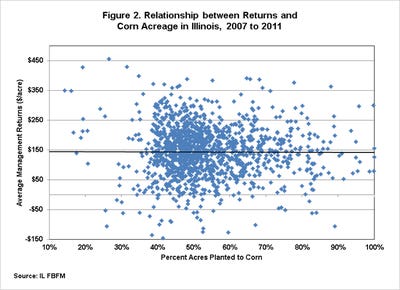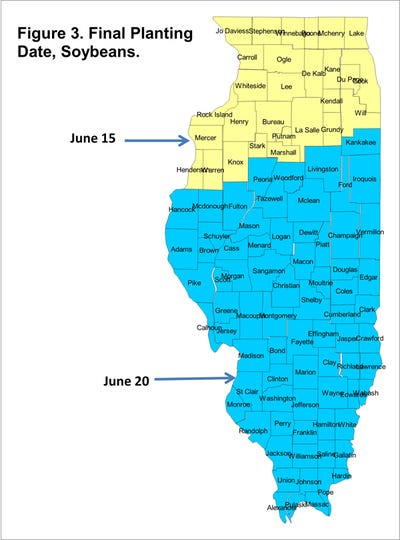March 13, 2013

COMBO crop insurance products — which include Yield Protection (YP), Revenue Protection with harvest price exclusion (RPwExcl), and Revenue Protection (RP) plans — have earliest planting dates and final planting dates. This year, the Risk Management Agency (RMA) revised earliest planting dates. This post details earliest and final planting dates for corn and soybeans in Illinois. It also provides a description of the impacts of these dates on insurance coverage.
Earliest planting dates
Three regions exist for earliest planting dates in Illinois (see Figure 1). Earliest planting dates in southern Illinois counties are April 1 for corn and April 15 for soybeans. Earliest planting dates in central Illinois are April 5 for corn and April 20 for soybeans. Earliest planting dates in northern Illinois are April 10 for corn and April 24 for soybeans.
 Acres planted before the earliest planting date are not eligible for replant payments if those acres need to be replanted. These acres will still receive full coverage for yield or revenue losses if good management practices are followed. For example, take RP with an 80% coverage level having a 170 bu. Trend-Adjusted Actual Production History (TA-APH) yield. With this year's $5.65 projected price, the minimum guarantee is $768 (170 bu. TA-APH yield x $5.65 projected price x .80 coverage level). The $768 per acre guarantee is in effect whether acres are planted before or after the earliest planting date.
Acres planted before the earliest planting date are not eligible for replant payments if those acres need to be replanted. These acres will still receive full coverage for yield or revenue losses if good management practices are followed. For example, take RP with an 80% coverage level having a 170 bu. Trend-Adjusted Actual Production History (TA-APH) yield. With this year's $5.65 projected price, the minimum guarantee is $768 (170 bu. TA-APH yield x $5.65 projected price x .80 coverage level). The $768 per acre guarantee is in effect whether acres are planted before or after the earliest planting date.
As is the case with planting after the earliest planting date, good farming practices must be followed on acres planted before the earliest planting date. For acres planted before the earliest planting date, this may be a particular issue if the early planted acres result in a poor stand. If good farming practices dictate those acres should be replanted, those acres need to be replanted even though those acres will not receive replant payments.
In most cases, the replant payment for corn will be $45.20 per acre for corn and $38.61 per acre for soybeans. The $45.20 corn replant payment equals 8 bu. times the 2013 projected price of $5.65 per bu. The $38.61 soybean replant payment equals 3 bu. times the 2013 projected price of $12.87. The 8 bu. corn and 3 bu. soybean factor remain the same across years. Projected prices vary by year, resulting in varying replant payments across years.
The $45.20 corn and $38.61 soybean payments are maximum payments. If a farm has APH yield below 40 bu. for corn or 15 bu. for soybeans, the replant payment will be the APH yield time 20% times the projected price.
Are you ready for planting? Get a roundup of the latest planter equipment and planting tips in a gallery.
Before replanting, a farmer should discuss replant with the crop insurance agent, assuring that requirements are met to receive replant payments.
Final planting dates
Final planting dates for corn are June 5 for all counties except for seven counties in southern Illinois (see Figure 2). The southernmost counties have a final planting date of May 31. For soybeans, counties in the northern one-third of the state have a final planting date of June 15. The remaining counties have a final planting date of June 20.
 Prevented planting payments can be taken if acres have not been planted by the final planting date due to weather problems. For a farmer to take a prevented planting payment, prevented planting must be prevalent on similar type of farmland within the area. The prevented planting payment is 60% of the final guarantee, unless the farmer opted for a higher percent level at crop insurance sign-up. As an example, take a corn RP policy with an 80% coverage level having a 150 APH yield. The projected price in 2013 is $5.65. This policy has a minimum guarantee of $678 per acre (150 bu. APH yield x $5.65 projected price x .80 coverage level). The prevented planting payment will be $407 ($678 x .60).
Prevented planting payments can be taken if acres have not been planted by the final planting date due to weather problems. For a farmer to take a prevented planting payment, prevented planting must be prevalent on similar type of farmland within the area. The prevented planting payment is 60% of the final guarantee, unless the farmer opted for a higher percent level at crop insurance sign-up. As an example, take a corn RP policy with an 80% coverage level having a 150 APH yield. The projected price in 2013 is $5.65. This policy has a minimum guarantee of $678 per acre (150 bu. APH yield x $5.65 projected price x .80 coverage level). The prevented planting payment will be $407 ($678 x .60).
Farmers cannot plant another crop during the late planting period (25 days after the final planting date). After the late planting period, another insured crop can be planted, usually resulting in reductions in the prevented planting payment to 35% of the above calculated amount. In double-crop situations, obtaining the entire prevented planting payment may be possible.
Planting after the final planting date
Farmers can plant after the final planting date; however, the guarantee will be reduced by 1% per day after the final planting date up to 25 days after the final planting date. After 25 days, the guarantee will be 60% of the guarantee.
In the above example, a farmer had a minimum guarantee of $678. Assume this farmer is in a county with a final planting date of June 5. If corn is planted on or before June 5th, the minimum guarantee is $678 per acre. Planting corn on June 6 will result in a guarantee reduction of 1% or $671 per acre ($678 x .99). Planting on June 7th results in a 2% reduction, or $664 per acre ($678 x .98). After 25 days the guarantee is 60% of the original, or $407 ($678 x .60).
 If prevented planting comes into play, alternatives should be discussed with a crop insurance agent. Prevented planting alternative can be complex, particularly where double-crop soybeans coverage is available.
If prevented planting comes into play, alternatives should be discussed with a crop insurance agent. Prevented planting alternative can be complex, particularly where double-crop soybeans coverage is available.
Summary
By planting before the earliest planting date, acres are not eligible for replant payments. However, those acres still receive full coverage for losses due to reduced yields and/or revenues. Final planting dates impact the availability of prevented planting payments.
Like what you’re reading? Subscribe to Farm Industry News Now e-newsletter to get the latest news and more straight to your inbox twice weekly.
You May Also Like




